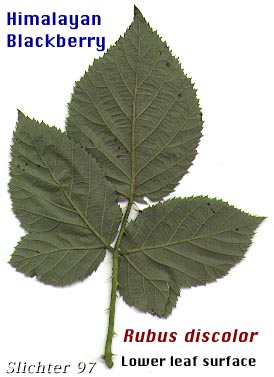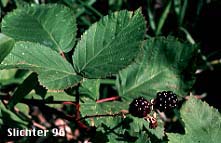

Himalayan Blackberry



Rubus ursinus --Dewberry or Trailing Blackberry

2. The upper leaf is dark green, while the lower leaf is a wooly, silver-white color.
3. The canes or stems are ridged lengthwise, square in cross-section, and very thorny.
4. The flower is white, with 5 petals and many stamens.
5. The berry is a bright black (It is a blackberry!) with many seeds.
 1. The ripe blackberries are eaten raw, in pies, jams, wines, etc..
1. The ripe blackberries are eaten raw, in pies, jams, wines, etc..
2. Himalayan blackberry is considered by many to be a bothersome, weedy shrub. It spreads easily by seeds dispersed by birds and small animals, and via its stems, which root upon contact with the ground. Once established, it can be very difficult to eradicate.
3. The fresh or dried leaves may be used in teas. Evidently the wilted leaves are poisonous, so it is advisable to take caution with this plant if you wish to brew a spot of fresh tea.
4. The himalayan blackberry is an import from Asia that easily escapes domestic use to establish itself where it is least desired.